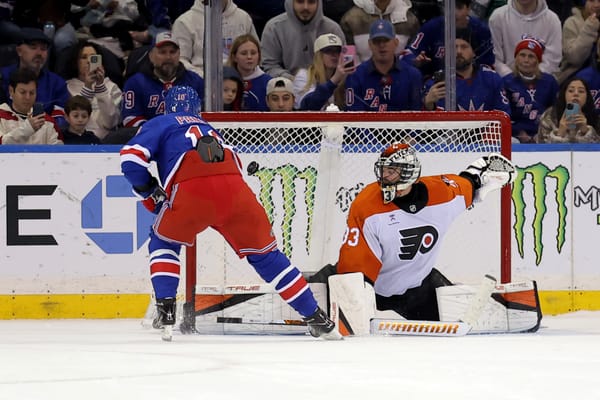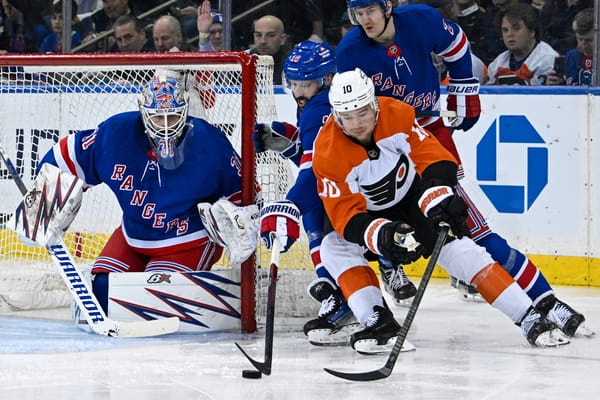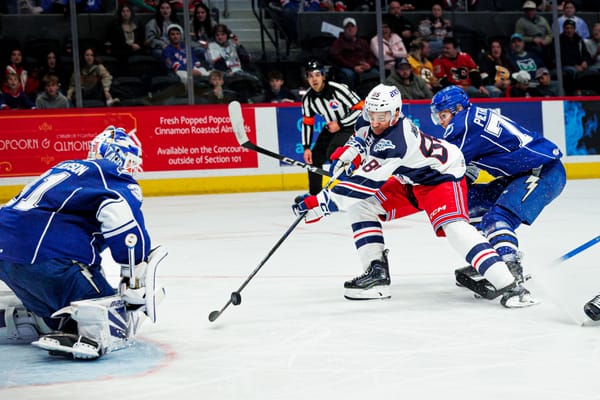2019 Report Card: Pavel Buchnevich
Buchnevich had another strong season, and developed a solid relationship with new bench boss David Quinn.
The 2018-19 season was Pavel Buchnevich’s third NHL season with the New York Rangers, and it was both a productive and interesting one. After skating in 74 games and tallying 43 points in 2017-18, the Blueshirts’ 2013 third-rounder was limited to 64 games this year. His absence was both due to injury — a broken thumb to be exact — and at times, a trip up to the “Quinn bin” for some instruction and course correction.
Raw Scoring
2018-19 was a career-year in terms of goal scoring for the then 23-year-old Buchnevich. The Blueshirts’ reluctant grinner found the back of the net 21 times in 64 games which was third-most among all Rangers.
Those 21 goals were seven more than his previous high of 14 in 74 games played. However, Buchnevich did this shooting 17.6% which is 5.2% higher than his career average heading into the season.
While there is some reason to be cautious, Buchnevich slightly upped his shots per game from the prior season. His 119 shots in 64 equates to 1.86 shots per game, which is up from 1.84 shots per game (136 in 74 games) last season. This isn’t a major increase by any means, but something to keep an eye on in future seasons.
Buchnevich averaged 0.33 goals per game, and over a full 82 game season that rate would be good for about 27 goals. Ideally the Rangers would love for Buchnevich to be a consistent 20 to 25-goal scorer, and I’d say 30 goals could be his ceiling in a career year where everything goes right. This season he also tallied 17 assists, and his 38 points in 64 games gave him a point per game average of 0.59; another career high.
Rate Scoring
Buchnevich finished with a points per 60 (P/60) of 1.57 and a primary points per 60 (P1/60) of 1.27 in 5v5 situations. This was a decline from the prior year in which he had a P/60 of 1.77 and a P1/60 of 1.36.
In all situations, Buchnevich finished with a P/60 of 2.35, and a P1/60 of 1.85. Both of these increased from the prior year in which he had a P/60 of 2.32 and a P1/60 of 1.73
The decrease in 5v5 production, but increase in all situations production are explained by Buchnevich’s proficiency on the power play this season.
In all power play situations, he was second-overall and first among forwards in P/60 (6.24), and third-overall and second among forwards in P1/60 (4.32).
Buchnevich’s seven power play goals were third-most on the team, and four less than Mika Zibanejad’s 11 in 82 games played. Buchnevich’s 13 points were fourth-overall and third among forwards behind Neal Pionk, Mats Zuccarello, and Zibanejad.
Fancy Stats
When it comes to underlying numbers, Buchnevich was in the middle of the pack for the Rangers. He was seventh among forwards with a 46.80 percent Corsi and a 1.40 relative CF%; he was also ninth in goals for (45.59 percent), Rel GF% (0.84), expected goals (46.06 percent), and Rel xGF% (-1.70).
Using Evolving-Hockey’s Goals Above Replacement (GAR) metric, Buchnevich was seventh among all Rangers skaters, and fifth among forwards, with a GAR of 3.3. This is calculated by taking Buchnevich’s -0.4 EV GAR, 2.7 PP GAR, 0 SH GAR, and 1 PENS GAR. In terms of WAR, he ranked fifth among forwards at 0.6, and was just 0.4 behind Zibanejad.
Buchnevich was one of the unluckier forwards, and his PDO of 99.39 was 12th among forwards. For context, Chris Kreider’s PDO of 102.3 was the highest among Rangers who were on the roster the entire season. Brendan Lemieux had a PDO of 104.48, and came over at the trade deadline from the Winnipeg Jets.
Deployment
Buchnevich averaged 12:34 a game at 5v5 which was seventh among forwards, and 15:10 in all situations which was ninth among forwards. Forwards directly ahead of Buchnevich in all situations include Jesper Fast (15:43), Vlad Namestnikov (15:47), Ryan Strome (15:54), and Jimmy Vesey (16:03).
An ATOI of 15:10 is nine seconds higher than 2017-18, and next season he should be somewhere between 16:00 and 18:00 per game. Kevin Hayes was in Buchnevich’s shoes at one point with limited ice time, and he jumped nearly 3:00 per game from his age 23 to age 24 season.
Here’s a look at some of the lines Buchnevich played on, with the bold text representing the highest total in each category.
Top Linemate Combos
One thing that stands out right away is the madness that was the line of Cody McLeod, Brett Howden, and Buchnevich, a trio that played nearly as much Filip Chytil, Zibanejad, and Buchnevich did this season.
Overall there are a lot of positives on this chart for Buchnevich, but there are a few negatives. The one common denominator with some of the negatives here involve Howden.
Howden had a tumultuous rookie season, and he spent a good deal of time with the offensive minded Buchnevich. This was likely done intentionally by coach Quinn to give Howden an offensive player to try and create with, as more established players were paired with Zibanejad and Kevin Hayes higher in the lineup. Howden showed some glimpses of offensive instincts and potential, but once he hit the rookie wall he was incapable of creating. This could be attributed to another things such as fatigue, deployment, bad luck, etc.
The brief time the duo of Buchnevich and Howden spent together along with Vlad Namestnikov was a pretty bright spot, and an unsustainable one as highlighted by the line’s PDO of 122.22. But then there were instances such as Vesey-Howden-Buchnevich and McLeod-Howden-Buchnevich which just didn’t work at all. For the sake of context, here’s a look at how Buchnevich’s numbers look away from Howden, and vice versa.
Buchnevich’s gains were greater when he was away from Howden, although collectively the duo improved in terms of GF% when together (albeit Buchnevich’s was drastically smaller than Howden’s).
When you consider that Buchnevich was put on a couple of different lines alongside rookies like Howden, and bottom-six players like McLeod and Boo Nieves, it is easy to see why he was closer to the bottom in key possession metrics among forwards. He isn’t at the point where Chris Kreider is yet when it comes to driving possession, a winger who can drive a line no matter the center, but there’s the potential for that to happen. Here’s a look at how the two stack up through their first 179 games played.
To reach 179 games, Kreider skated 23 games in his first season, 66 in his second season, 80 in his third season, and I took the first 10 games of his fourth season. Buchnevich skated 41 games in his first season, 74 in his second season, and 64 this past season.
Thus far into his career, Buchnevich is trending in the right direction, and looks pretty solid compared to Kreider. Obviously the underlying numbers span multiple seasons and linemates, but the overall picture suggests that Buchnevich has the opportunity to be a productive top-six forward at the NHL level.
The reason I draw the comparison is because this summer the Rangers have some decisions to make in free agency, and it would be wise to learn from their history, use the results available currently, and try and project into the future; more on that in a couple lines.
From career game 180 on — 281 games to be exact — Kreider’s scored 92 goals and added 88 helpers for 180 points. From a rate perspective that’s 0.32 goals per game, and 0.64 points per game; or 26 goals and 52 points over an 82 game season.
With Buchnevich trending slightly ahead, there’s reason to believe he should match that production at the very least, and that would be a great thing for the Rangers.
Grade: A- | Banter Consensus: A-
This season a number of forwards took a next step forward under David Quinn, and Buchnevich was one of them. Quinn was impressed with how Buchnevich progressed, and it sets up a situation for the Rangers’ young winger to get off on the right foot at the start of the 2019-20 season.
Quinn deserves credit for the approach he took to get the most out of Buchnevich — one that involved consistent communication, unlike the tactics employed by his predecessor. Still, there was already evidence that showed what Buchnevich was capable of before this season and approach.
Prior to suffering a concussion last season, Buchnevich was on the right track with 32 points in his first 50 games. He would end the season with 43 points, and that left fans wondering “what if?” Next season there’s a chance that the winger group involves Vitali Kravtsov and Kaapo Kakko, and it’ll be interesting to see where he slots in the lineup.
Buchnevich is an RFA who needs a new contract, and a bridge deal would likely see him make at least $3 million a season. Kreider’s second contract carried an AAV of $2.475M, and it was worth 3.59% of the cap at the time of signing.
Next year’s cap estimate is $83 million, and 3.59% of that would be $2.98 million when you round up. Considering that the team is flush with cap space, and Buchnevich has been better than Kreider, anything between $3 to $3.25 million would be a realistic “bridge offer.”
The Blueshirts have the room to take a risk and offer Buchnevich a five or six-year deal, but there’s a good chance that Mr. Magnet will bet on himself in order to earn an even bigger payday. No matter what happens; there’s a lot of reasons to be excited about Buchnevich next season.
Stats via Cap Friendly, Corsica, Evolving-Hockey, Hockey Viz, and Natural Stat Trick unless otherwise noted.
2019 Report Cards: Ryan Strome | Filip Chytil | Brendan Lemieux | Tony DeAngelo | Chris Kreider





